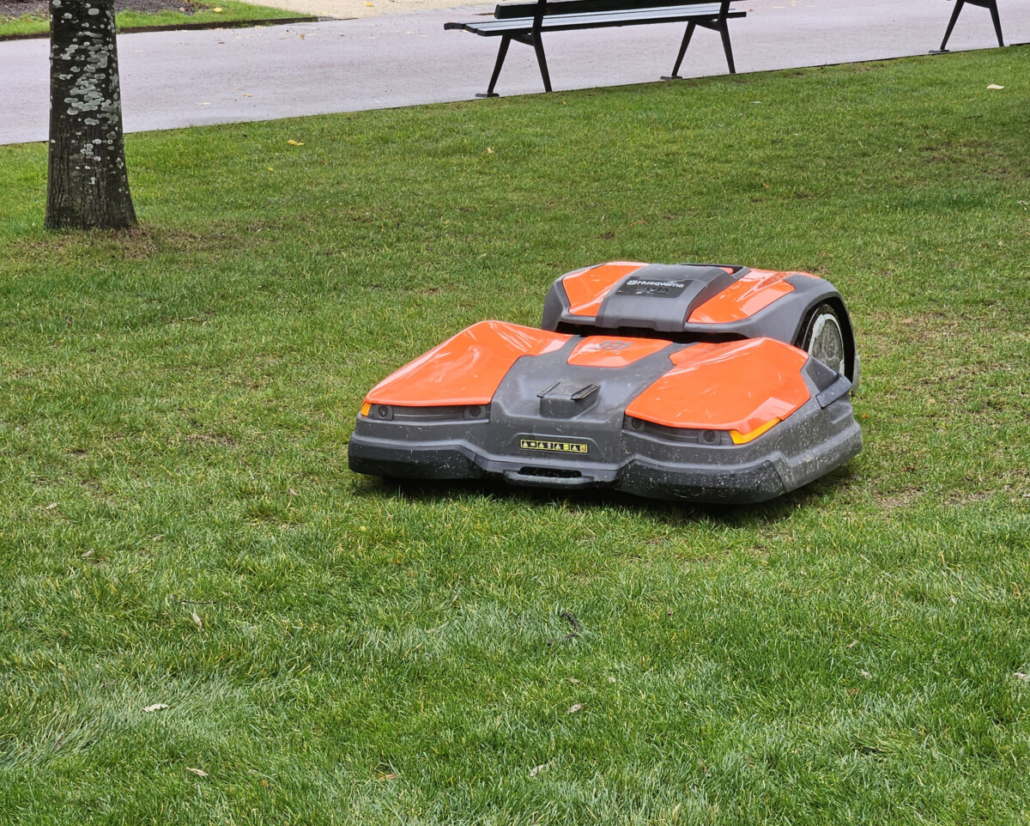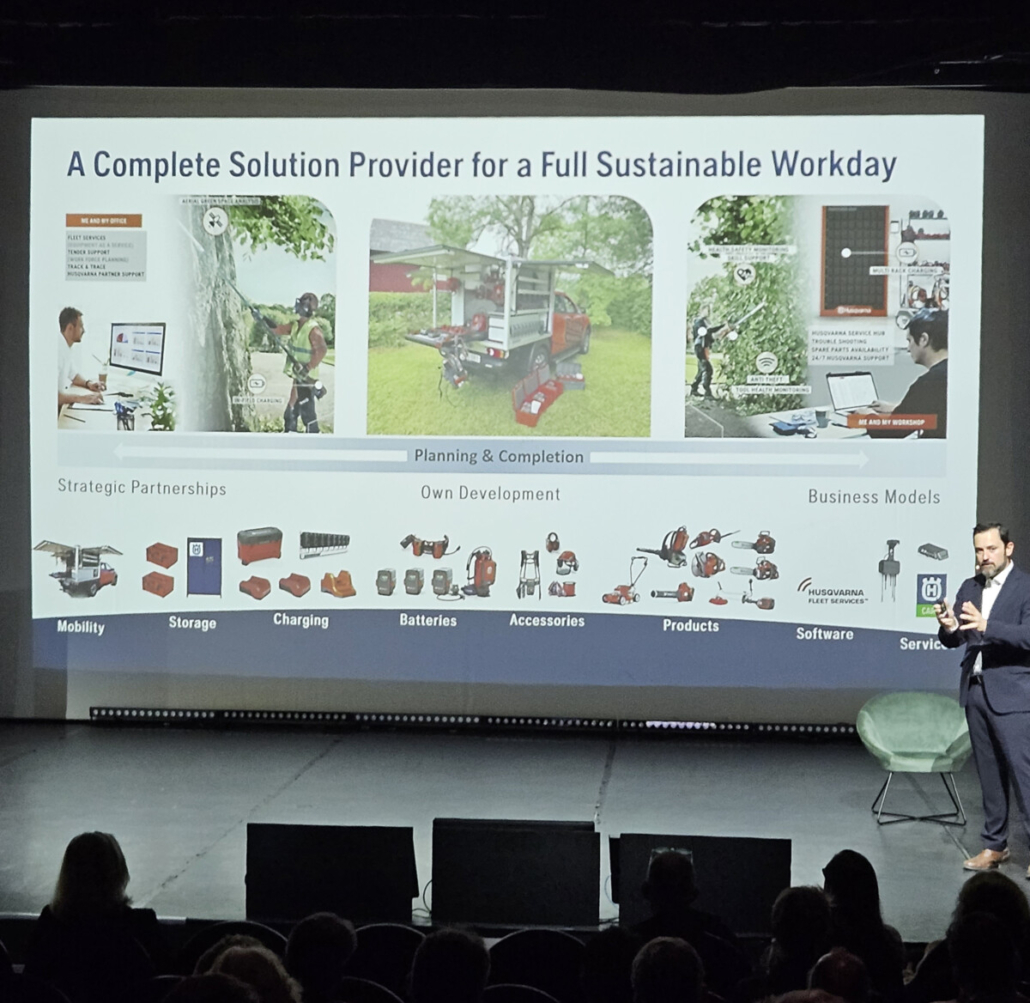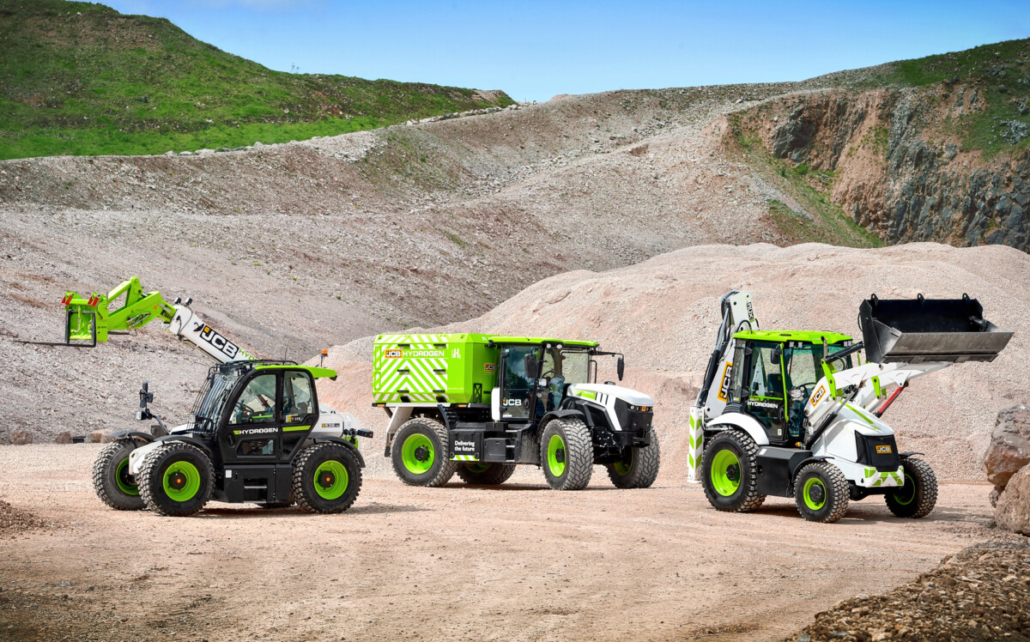The Future…
The Future…: With Turf Matters celebrating its 10th birthday thoughts go to 10 years down the line and what life will be like in the mid 2030s. Scott MacCallum was given a glimpse into the future by Husqvarna and JCB.
In many ways, 2014 seems like ancient history. Back then, we saw Scotland voting to remain as part of the United Kingdom; Brazil were tonked 7-1 in the semi-final of a World Cup… held on home turf in Brazil, and Conchita Worst, sporting a very fine gown and a very fine beard, won the Eurovision Song Contest for Austria.

The Future…
It was also the year that Turf Matters was launched, and this issue represents the 10th anniversary of the magazine.
With so much, good and bad, occurring over the last 10 years, it led to me to ponder where we might be 10 years from now. Could we be being picked up from the pub in our driverless car; might we have all our mail and deliveries dropped down to us from drones, while might we all have chips inserted in our wrists, thus removing the need for all money, keys and forgettable passwords?
But what about our industry? What are some of the things that we might expect when the 20th anniversary Turf Matters drops to you from your friendly drone… Hang on… will we still have printed magazines in 10 years’ time?
Now I don’ t have a crystal ball but I have been lucky enough recently to attend two events which shed some considerable light on what developments are being made towards 2034 and beyond. A quote which is attributed to either science fiction writer Arthur C. Clarke or Bill Gates, and raised in Paris, and tweaked slightly for our needs is also worth re-stating.
“We tend to overestimate what can be achieved in two years but underestimate what can be achieved in 10.”
Husqvarna’s Living City 2023, held in the wonderfully nostalgic Jardin d’Acclimatation, in Paris, was a two day look into the future, while a couple of weeks later I was one of a select group of journalists invited to attend a briefing at JCB’s Headquarters, in Staffordshire, to look at the extraordinary progress they have made in hydrogen power.
What I discovered was that 10 years is well within the scope of some amazing advances in technology and thinking. Looks like Arthur or Bill might have been spot on.
Living City 2023, saw 160 people attend for 13 different countries and covered a range of topics from global change and how that was impacting cities – the temperature rise in northern hemisphere cities is four degrees against a global rise of one and a half degrees – to how biodiversity 10 years down the line will be increasingly seen as the lifeline for the future of the planet.
Paris has a target to be the greenest city in the world by 2030 while London Mayor Sadiq Khan has promised to plant two million more trees in the city. New York has a policy of every missing tree having to be reported
One speaker was Douwe Snoek, a renowned Dutch landscape architect, who told the audience that we had been building our cities all wrong. Douwe will be featured in the next issue of our sister publication, Landscaping Matters, but in essence he said that too much influence had been given to the car and future cities should give limited access to the car.

The Future…
Opening the Conference Yvette Hensall-Bell, President Global Professional for Husqvarna, revealed that more than one million species were at risk of extinction if the status quo was maintained and said that the company had set up a Biodiversity Advisory Board, pulling together some of the finest minds on the subject to work on finding solutions and lobbying Governments.
They also presented papers on how there will be a return to quietness, with the removal of the brute force of engines and all the toll that puts on the body.
Gent Simmons, Vice President Global Product Management & Development – Professional, spoke on the need for sustainability in all areas, even citing safety trousers which currently tangle in a chainsaw to bring it to a sharp stop, at the overall expense of the trousers. Building sensors into safety trousers would instantly bring the chainsaw to a halt and not damage the trousers.
“It is about encouraging customers to move from more of a business model approach to a more sustainable one and adding customer value is how this is achieved,” explained Gent, adding that no new project at Husqvarna progresses now, until it is proven to be fully sustainable.
“No project will be started without a plan to have fossil independence,” said Gent, who added that the philosophy at Husqvarna is to encouraged engineers not to make “new stuff” but to make “stuff better”.
Gent’s closing words were that his greatest wish was to return nature’s balance, something which we’d lost over recent years.
So what else?
Well, we’ve had robots for a number of years now which have become adept at cutting lawns or amenity areas before heading back to their base to recharge.
Well how about, in 10 years’ time, a team of robots which will carry out a range of different turf management practices – aeration, chemical application etc – silently in the middle of the night?
And these robots won’t need to be guided by satellite or guide wires, they will be using AI to work autonomously able to identify where they can and cannot go and, in a golf environment, know the difference between fairway, greens and bunkers.
The robots will arrive in a mini vehicle which will act as their recharging base while they are on site.
With the current recruitment crisis within the industry, it will allow human staff to get on with important jobs during their regular working hours.
For more remote working Husqvarna’s R&D has given thought and provided solutions to the challenge of powering chainsaws and the like for a full working day. Among those was a fully kitted out vehicle with recharging points and storage for all manner of spare batteries and equipment itself.
Much of the pathway to progress revolves around battery power, something which Husqvarna believes will be essential for hand tools for the foreseeable future, and which is make more possible by innovative ways of recharging and supplying sufficient batteries for an entire day’s work. It is worked that is being mirrored at many of the most innovative hand tool companies in the world including Stihl and Pellenc, both of whom are well advanced with their own battery power development work.
Interestingly, however, they believe that hydrogen is the ultimate fuel to provide fossil independence. The problem for the hand tool industry is that currently a hydrogen powered hand tool would need to be six times larger than they are at present.
That obvious limiter to progress does not stand in the way of JCB, whose range of vehicles are sizeable enough to cope with a hydrogen engine.

The Future…
How do they know? Well they’ve built one and it is already powering prototype JCB’s at their testing quarry a few miles from their Headquarters.
In fact, a fully fledged hydrogen engine was not the first option considered when viable alternatives were being assessed by the JCB engineers. Further up that list were indeed, battery and hydrogen fuel cells, which initially ticked a lot of boxes and where thought be a quicker route to zero carbon fuel.
While extensive research determined that battery is still the optimum non-fossil option for smaller vehicles, including in that category, domestic cars, it is not practical for equipment with an operating weight of over six tonnes.
JCB’s chief innovation and growth officer, Tim Burnhope, one of the most decorated engineers in the country, explained that with domestic cars now averaging 8,000 miles a year, a drop from the pre Working from Home era of 12,000 miles, battery power remains more than a viable option.
“At JCB, we believe that it is important to use the right technology for the right application. For low power applications, close to built infrastructure, and potentially with additional demands on product such as noise, and where fume extraction is an issue, battery-electric technology is applicable,” said Tim
“These machines tend to be more compact, due to the nature of the work, and while are on-site all day, generally only work a couple of ‘power hours’ in a day. An example of this in the turf and landscaping industry would be electric ‘golf’ buggies, which have been commonplace for many years due to their low power application, low noise and proximity to charging infrastructure.”
For huge excavators, which in countries like India car run for 22 hours a day, lifting and emptying fully loaded buckets every 21 seconds, batteries wouldn’t cut the mustard.

The Future…
“For larger machines and equipment, the job site tends to be more remote, building the infrastructure need (e.g. utilities, road, rail, and housing) for the first time. As such fuel needs to be mobile and fast to replenish to enable machines to operate whenever and wherever they are needed to. Hydrogen is a zero carbon fuel, which can be brought to machines and refuelled in a matter of minutes – making it an ideal future fuel for construction and agricultural machines.”
The example Tim gave was of a busy quarry with 100 excavators. The required recharging points would mean that power would require to be drawn from a considerable distance at a current installation cost of £1 million a mile. Of course, when the quarry was drained of resource the expensive recharging infrastructure would be redundant.
“Continuing down the battery power route would also mean that net zero by 2050 would not be achieved, as predictions suggest that it would stop at around 10%,” explained Tim.
The hydrogen fuel cells also had similar success-limiting deficiencies.
“We worked at developing a machine which would work for 16 hours a day, not even the 22 hours that is required in places like India. However, even that would require £400,000 worth of fuel cells – 4.3 times the cost of an existing excavator, and it would weigh 10,000 kilos.”
Machines must also have a resale value to make them viably options for customers and having been worked at such a rate they wouldn’t be an attractive proposition without a hugely expensive replacement battery pack.
“Hydrogen fuel cells were therefore too complicated, not robust and too expensive,” explained Tim.
And so it was that during a break in Covid lockdown in 2020 a team of JCB engineers sat down with Lord Bamford, JCB’s Chairman
“It was July and Lord Bamford laid down his Chairman’s Challenge. He wanted us to produce a hydrogen engine by Christmas,” recalled Tim.
Now, rather than leave the meeting with spinning heads and a desire to find the nearest darkened room in which to lie down, the team of engineers got to work and met the Challenge. Not surprising when you appreciated the desire and ability of the JCB engineers to the push the envelope. The world’s fastest diesel vehicle, as driven by Andy Green, sits in the corner of the factory floor. It achieved a speed of 365 mph on in Utah, USA, in 2006, if you are interested.
The engine they produced has the same dimensions as that used in fossil fuel-operated JCB machinery, so can be fitted into the same chassis while they have the same level of performance.
It is a huge breakthrough and JCB is now just the first of at least 130 hydrogen development programmes going on around the world at some of the biggest companies in a range of different usages so progress will undoubtedly intensive.
The one challenge which is still to be met satisfactorily is refueling.
An extensive nationwide set of hydrogen filling stations is a long way off so a solution for the early adopters of hydrogen powered machines had to be found.
JCB have come up with, and built, a mobile hydrogen filling vehicle which would travel around an area refilling hydrogen machines thus ensuring that down time for those valuable workhorses is minimised.
That may be a useful option for operators of a large fleet of machines or those who tap into a refilling service but the dream of freely available hydrogen filling stations is still a little time away.
So, that question of where will we be when Turf Matters celebrates its 20th birthday…
“The landscape in 10 years’ time will certainly be a growing mixture of both technologies; where the line is between the two will be highly dependent on application, location and cost,” predicted Tim.
Overall the glimpse into the future, as offered by both Husqvarna and JCB, is extremely interesting and shows that the landscape of our workplace, and life in general, will be markedly changed. Husqvarna’s work on battery development and holistic lifestyle changes and JCB’s progress on ensuring that large vehicles will emit steam rather than fumes should assist in achieving, or getting close to, nett zero
Many thanks to Husqvarna and JCB for inviting Turf Matters to two extremely interesting events




















